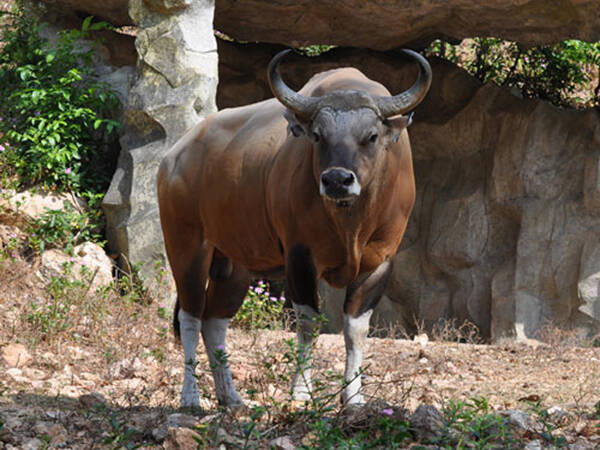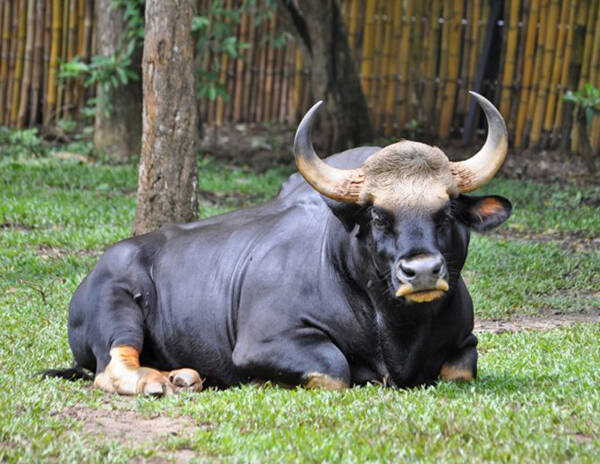Bos sauveli
IUCN
LCBasic Information
Scientific classification
- name:Bos sauveli
- Scientific Name:Bos sauveli,Kapolei cattle, gray cattle
- Outline:Ungulata
- Family:Artiodactyla Bovidae Bos
Vital signs
- length:2.1-2.23m
- Weight:680-910kg
- lifetime:About 20 years
Feature
They are tall but narrow, and their hair is mostly brown, with older males having black hair.
Distribution and Habitat
Distributed in Cambodia and Laos.
Extinct: Thailand and Vietnam.
The range of the Cambodian wild bull once extended from Cambodia to the Dongrak Mountains in eastern Thailand, southern Laos, and western Vietnam. It is considered extinct in these areas, with only individuals possibly surviving in a small area of eastern Cambodia where some poorly protected areas exist.
The Cambodian wild bull lives in areas with elevations ranging from sea level to 50 m above sea level. It is an animal that lives primarily in open deciduous Dipterocarp woodlands, especially those with dense vegetation. Although deciduous Dipterocarp trees are widespread in parts of Cambodia and neighboring countries (especially Laos and Vietnam), the preferred sites of the Cambodian wild bull are more localized, perhaps less than 30% of the total lowland area. The species inhabits mosaic forests dominated by deciduous trees, which are mixed woodland blocks of deciduous and semi-evergreen forests. Most of the
Appearance
The Cambodian wild cattle is 170-90 cm wide at the shoulder, 210-223 cm long, 100 cm long tail, and weighs 680-910 kg. Adult males have a distinct dewlap (drooping skin at the base of the neck) on their necks that is 40 cm long and may touch the ground, which distinguishes it from other wild cattle. Both sexes have horns that spiral upward. The horns become cracked and worn at the tips when they are about three years old. The male's horns are large trumpet-shaped, arched forward and upward, with cracked edges, and can be up to 80 cm long. The female's horns are about half the length of the male's horns, 40 cm long, and lyre-shaped. Both sexes have strange nostrils with notches. They have long tails.
Calves are brown at birth, turning gray as they age, and becoming a darker gray at 5-6 months old. The belly and lower legs are lighter in color. When males mature, their color also changes to dark brown or black.
Details
Cambodian wild cattle (scientific name: Bos sauveli) English Kouprey, Grey Ox, French Boeuf gris Cambodgien, Spanish Toro Cuprey, German Kouprey, no subspecies. Cambodian wild cattle are a particularly rare wild cattle native to Southeast Asia. Scientists did not discover this wild cattle until 1937. It is the latest discovered large animal and its classification is still controversial. Some zoologists believe that it is a true wild cattle that has become an independent species; some believe that it has been domesticated for centuries and then became a wild cattle; some believe that it is a hybrid.

Cambodian wild cattle live in small groups, mostly females and calves, with up to 20 animals. Mature males form bachelor herds. They have developed a nocturnal lifestyle, apparently to avoid humans. They retreat to the forest during the day to avoid the scorching sun, and emerge in the open in the evening. In the dry season, the herds are active and restless. Males use their horns to dig in the ground and into tree stumps, causing wear and tear to the horns. They are more alert and run more gracefully than other members of the same genus. They often travel with Javan wild cattle and other wild water buffaloes. They roam up to 15 kilometers each night when grazing. The herds often separate and reunite.
As mammals, Cambodian wild cattle probably use some visual signals and body postures in communication. Smell may play a role, especially in identifying mates and offspring. The species often vocalizes to each other. Tactile communication may be important in competition for mates and between mothers and offspring.
The diet of Cambodian wild cattle is mainly various sedges, including the genus Acanthus and the genus Chloris. They often lick salt and wallow in puddles.

Cambodian wild cattle are sexually dimorphic and somewhat polygamous. In other bovids, males often compete for females, and the males succeed. This species is likely similar. Females are low in fertility. They mate in spring around April, with a gestation period of 8-9 months, and calve in winter (usually December to February of the following year). The mother leaves the herd to give birth, giving birth to one calf per litter, and returns to the herd about a month later with the calf. As with other mammals, females provide care, suckling young calves, grooming them, and protecting them from danger. Lifespan is about 20 years.
The Cambodian wild cattle are most likely extinct. The species number fewer than 250 mature individuals. High levels of hunting in the range have led to a significant population decline, with the species suspected to have decreased by more than 80% in the past 30 years (estimated generation length of 8-10 years) (as of 2020).
The Cambodian wild cattle are legally protected in all countries of their range. If the species still exists, it is probably in one of four protected areas in eastern Thailand (Phnom Penh Preet Wildlife Sanctuary, Lombat Wildlife Sanctuary, Mondulkiri Protected Forest, and Siem Town Biodiversity Reserve). In situ conservation of mammal communities, especially strengthening existing projects in the Srepok Wilderness Area (Srepok) of the Mondulkiri Shelterbelt Forest and the Siem Biodiversity Conservation Area.
Listed in the IUCN Red List of Threatened Species 2016 ver 3.1 - Critically Endangered (CR).
Listed in Appendix I of the CITES Convention on International Trade in Endangered Species of Wild Fauna and Flora (CITES) 2019 edition Appendix I.
Protect wild animals and stop eating game.
Maintaining ecological balance is everyone's responsibility!








